Field Test: Are These Spy Camera Sunglasses with a Built-In MP3 Player Worthy of James Bond or Mr. Bean?
posted Wednesday, June 20, 2012 at 8:13 AM EST
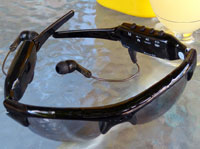 While the others at Imaging Resource get to review exciting new digital cameras, I try out things like the $29.99 “Spy Camera Sunglasses with MP3.” Receiving a press release from a Chinese company announcing its new Spy Camera Sunglasses, it fell to me to “field test” them.
While the others at Imaging Resource get to review exciting new digital cameras, I try out things like the $29.99 “Spy Camera Sunglasses with MP3.” Receiving a press release from a Chinese company announcing its new Spy Camera Sunglasses, it fell to me to “field test” them.
I had, after all, written about Lady Gaga’s non-existent camera sunglasses and the equally unavailable camera radio.
Okay, admittedly when the Spy Camera Sunglasses arrived, I felt none of the excitement I experienced when I got a new X10 from Fujifilm to test. But, I am a pro and disappointment aside, I proceeded to empty the sunglasses box onto a table to see what my $29.99 had gotten me.
Beside the glasses, there were two individual ear buds on short cords, a USB cable with mini-earphone jack, a battery charger, a lens cleaning cloth, a hard shell eyeglass case and a tiny, 8-page instruction manual in both English and Chinese.
The Design
The sunglasses are molded black shiny plastic and while they don’t look all that geeky, no one would mistake them for a pair of Dolce & Gabbana’s. The guts of the camera are in the eyeglass wings. The right one has an earphone jack and contains the embedded battery, the other holds the operating control buttons, an earphone jack, and a micro SD slot. (The sunglasses do not come with a micro SD memory card. You need will need one that's about 2-4 GB.)
The sunglass buttons (see photo below) are for selecting the mode (audio, video or still), a shutter release/volume down, an on-off/video pause and nearest the Polaroid-like plastic lenses, and a video/volume up control.
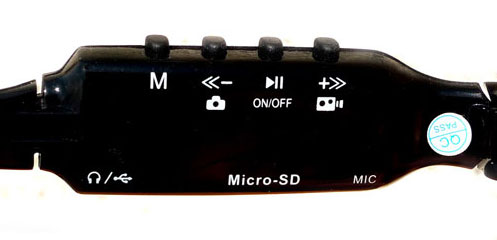
After charging the Spy Camera Sunglasses for about two hours, I popped in a micro SD card and plugged the USB cord into my PC. I uploaded some music -- The Rolling Stones' “Exile on Main Street” album -- and attached the ear buds. Pressing the on/off button, a blue LED came on just below the M button. Putting on the glasses, I could clearly hear Keith Richards singing. The volume was good and it sounded fine. Encouraged by this, I stepped out my front door and into the field of tests, happily singing, “I need a love to keep me happy.”
My first stop was the local café to see what sort of reaction the sunglasses would evoke. Would people notice them and what would they think? Were these, as advertised in the promotional material, "the perfect eyewear for police surveillance" or did they scream "dork!"
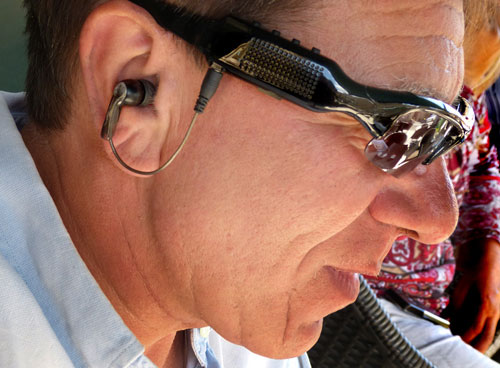
Sitting down at a table, I waved to the owner for a coffee. Then, casually pressing the Mode button, I turned off the MP3 player and turned on the camera. The blue LED went orange. Just then an older gentleman I know came over and shouted, “Good morning, Steve!”
He thought I was wearing some sort of hearing aid!
Next, the cafe owner arrived with my espresso. Setting the coffee in front of me, she winked and said in a very soft voice, “Good morning, double-O seven.”
Dammit, my cover was blown. The sunglasses obviously looked like “spy” gear or worse yet, a hearing aid.
The Field Test
Shaken but not stirred, I said to myself, “Okay, this is a field test. So let’s find a field and test them.”
After finishing my coffee, I went off to stroll around the village and into one of the vineyards. Two hours later, I returned home and via the USB cable, easily uploaded video and stills images to my computer.
The camera sunglasses are "point and shoot" in its purest sense. There is no LED monitor, no optical viewfinder, no frame indicator, nada. The camera lens has a narrow field of view -- like a 60mm lens (in 35mm) -- and is in the bridge of the glasses over the nose.
To take pictures I realized I would have to learn to “point” with my nose. Nose aiming is not easy and many photos were of bits of sky and arbitrary parts of legs and blurred pavement.
However, within days, I learned to point and frame with my nose. I could even inconspicuously raise my hand to the shutter button, pressing it while pretending to brush my hair back.
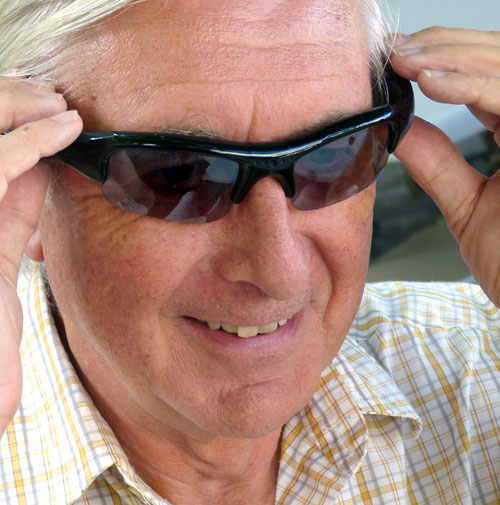
Shutter lag, even outdoors, in bright sunlight was about a full second. In shadowed areas and indoors, it could be four or five seconds. This could be problematic for a spy since it is hard not to look suspicious while staring immobile at a subject, immobile, for several seconds.
The Results
Taking videos was worse than shooting stills. Turning my head to pan a scene, the video I shot resembled a dashboard cam recording of a head-on auto collision.
Discouraged but not disheartened, I deleted most of the first pictures and went back out into the "Field." Working more slowly this time, I tried to hold my head to avoid sky and ground shots and not to move after pressing the shutter.
These small images taken by the Camera Sunglasses are rather, oh I don’t know, “impressionist” is a good word. The camera sensor is very small and its 1.2 million pixels don’t seem to work together a lot of the time.
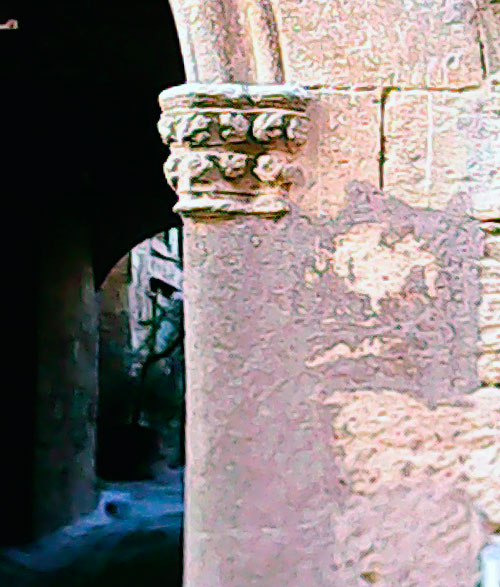
Color fringing is normal throughout the frame, but hey, that just adds interest to otherwise dull images of the cropped tops of people’s heads. There’s lots of color shift too and it's sort of random, which adds a good deal of surprise to the camera’s pictures.
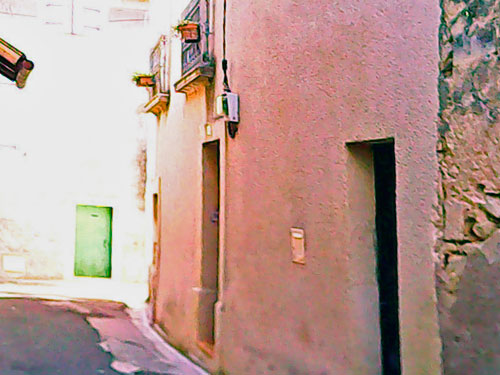
Nonetheless, I did learn a few lessons testing these sunglasses. First, a little humility, because these humble glasses do take pictures and after awhile I began to enjoy the crazy images. It reminded me that we photographers can get too close to our gear and forget that photography should be fun, at least some of the time.
Under Surveillance
Ironically, though, the camera sunglasses made me feel more compassionate for those poor police/photographer toadies working for the Czech dictatorship that I wrote about in April. Their devices were a lot like the Spy Camera Sunglasses.
Things like the baby carriage camera the secret police used had no framing device and no monitor and were probably just as hellish to use. It may well have been that they were really trying to take photos of the enemies of the state. But the guesswork and by-gosh nature of their cameras meant they came back from the mean streets of Prague with hundreds of thousands of pictures of bits of the mean streets themselves.
Good Fun
Nonetheless, for all its faults, I would recommend the $29.99 "Spy Camera Sunglasses with MP3" to friends. It is like a clown nose or a rubber chicken: something stupid, that brightens one’s day.
Which is what happened with almost everyone I met in my field tests. They were curious about the camera sunglasses and most wanted to try them on. When they did, they would smile and say in their best Sean Connery voice: “The name’s Bond, James Bond.”
However, one young woman told me she loved the glasses but when I told her she couldn’t make calls with it, she handed it back and walked away saying: "Bummer."
Uh-oh, sounds like Lady Gaga’s camera sunglasses could be a very tough sale.
You can buy the Spy Camera Sunglasses for $29.99 here.
A test video captured with the sunglasses is below.